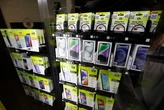As of this year, EV chargers now outnumber gas pumps in the state of California.
The state has an estimated 178,000 shared chargers for electric cars—not counting another 700,000 private chargers that are installed in single-family homes, according to the California Energy Commission. That’s compared to roughly 120,000 gas pumps across the state.
The number of EV chargers nearly doubled since 2023, though part of the increase came from identifying charging stations that hadn’t previously been counted. The official stats include both public chargers and those that are shared at workplaces or in apartment buildings.
It’s still only a fraction of the number of chargers that are coming. By the most recent estimate, California will need around 1 million public and “shared private” chargers by 2030, enough to support the estimated 7 million light-duty electric vehicles that may be on the road by then. By 2035, when a rule requiring new vehicles to be electric will go into effect—the state could need more than 2 million shared EV chargers. (That’s assuming the rule survives Trump’s attempts to kill it.)
For drivers who own a house with a garage, charging overnight at home can easily cover most needs. Still, those drivers obviously need access to public chargers for longer trips. And around 45% of Californians are renters who don’t have garages of their own. New building codes require new apartment buildings to make parking spaces EV ready, and also apply to existing parking spaces when older buildings are renovated or expanded. Renters also have the right to install chargers themselves when they have a designated parking space. The rules also require a certain number of parking spaces at motels and retail and commercial parking lots to be EV ready. “Retrofitting the existing stock of multifamily dwellings with chargers is a substantial challenge,” says Esther Conrad, a research manager at Stanford University who has studied the rollout of EV chargers.
Charging EVs takes substantially longer than filling up with gas, which is the main reason so why more charging ports are needed than gas pumps—both in order to prevent bottlenecks at charging stations and because chargers are used in different places, from parking lots to street parking in cities. But as charging tech and vehicles improve, the total number of chargers that are needed is likely to shrink from current estimates, says Harrison Reilly, a spokesperson for the California Energy Commission. (In China, tech is already much farther ahead, with some new cars capable of charging in roughly as quickly as it takes to pump gas.) The state will publish a new estimate of charging needs later this year.
For the moment, Reilly says, there are enough chargers to support the number of light-duty EVs that are on California roads. That’s a major milestone; with nearly 2 million electric cars and light-duty trucks, California also has more EVs than any other state. Last year, around 25% of all new car sales there were electric.
Other states can learn from California’s policy. “First, states should be developing clear and ambitious EV targets, especially as the federal government pulls back on some of the targets for the transition,” says Jeff Prosserman, CEO and cofounder of Voltpost, a company that converts streetlights so they can double as curbside EV chargers. “They were leading the charge by looking to have as a mandate 100% of new car sales to be electric by 2035.”
The state’s requirement for new apartment buildings to add EV chargers is critical. It has also provided important financial support, including grants to add chargers in disadvantaged neighborhoods, and has pushed to help streamline permitting so projects can be built faster.
There are still obstacles as it moves forward. “One of the big challenges is the need for additional grid capacity to handle all of the charging,” says Conrad, though the state is trying to help address that. She says that even more funding is needed to add chargers in some locations where private developers might not otherwise build them. As the Trump administration tries to cancel promised support for EV chargers, it puts more financial pressure on the state.
But the network is still quickly growing now. Voltpost, for example, is moving forward on a project to add curbside EV chargers in some neighborhoods in San Francisco. “It’s in no way impacted by federal policy—it’s state and city-driven,” says Prosserman.
“From what we’ve seen at Voltpost, progressive states like California are going to continue providing funding opportunities to meet their climate targets with or without support from the federal government,” he says.










No comments